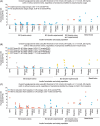Clinical perspectives on the frequency of hypoglycemia in treat-to-target randomized controlled trials comparing basal insulin analogs in type 2 diabetes: a narrative review
- PMID: 38749508
- PMCID: PMC11097869
- DOI: 10.1136/bmjdrc-2023-003930
Clinical perspectives on the frequency of hypoglycemia in treat-to-target randomized controlled trials comparing basal insulin analogs in type 2 diabetes: a narrative review
Abstract
The objective of this review was to comprehensively present and summarize trends in reported rates of hypoglycemia with one or two times per day basal insulin analogs in individuals with type 2 diabetes to help address and contextualize the emerging theoretical concern of increased hypoglycemic risk with once-weekly basal insulins.Hypoglycemia data were extracted from treat-to-target randomized clinical trials conducted during 2000-2022. Published articles were identified on PubMed or within the US Food and Drug Administration submission documents. Overall, 57 articles were identified: 44 assessed hypoglycemic outcomes in participants receiving basal-only therapy (33 in insulin-naive participants; 11 in insulin-experienced participants), 4 in a mixed population (insulin-naive and insulin-experienced participants) and 9 in participants receiving basal-bolus therapy. For the analysis, emphasis was placed on level 2 (blood glucose <3.0 mmol/L (<54 mg/dL)) and level 3 (or severe) hypoglycemia.Overall, event rates for level 2 or level 3 hypoglycemia across most studies ranged from 0.06 to 7.10 events/person-year of exposure (PYE) for participants receiving a basal-only insulin regimen; the rate for basal-bolus regimens ranged from 2.4 to 13.6 events/PYE. Rates were generally lower with second-generation basal insulins (insulin degludec or insulin glargine U300) than with neutral protamine Hagedorn insulin or first-generation basal insulins (insulin detemir or insulin glargine U100). Subgroup categorization by sulfonylurea usage, end-of-treatment insulin dose or glycated hemoglobin reduction did not show consistent trends on overall hypoglycemia rates. Hypoglycemia rates reported so far for once-weekly basal insulins are consistent with or lower than those reported for daily-administered basal insulin analogs.
Keywords: Diabetes Mellitus, Type 2; Hypoglycemia; Insulin.
© Author(s) (or their employer(s)) 2024. Re-use permitted under CC BY-NC. No commercial re-use. See rights and permissions. Published by BMJ.
Conflict of interest statement
Competing interests: JR has served on advisory panels for Applied Therapeutics, Biomea Fusion, Boehringer Ingelheim, Eli Lilly, Endogenex, Hanmi, Novo Nordisk, Oramed, Regor, Sanofi, Scholar Rock, Structure Therapeutics, Terns Pharmaceuticals and Zealand Pharma; and has received research support, consulting fees or honoraria from Applied Therapeutics, AstraZeneca, Biomea Fusion, Boehringer Ingelheim, Eli Lilly, Endogenex, Hanmi, Novo Nordisk, Oramed, Regor, Sanofi, Scholar Rock, Structure Therapeutics, Terns Pharmaceuticals and Zealand Pharma. HSB reports trial fees paid to his institution by Amgen, AstraZeneca, Boehringer Ingelheim, Ceapro, Eli Lilly, Gilead, Janssen, Kowa Pharmaceuticals, Madrigal Pharmaceuticals, Merck, Novartis, Novo Nordisk, Pfizer, Sanofi, Ionis and Tricida. IL reports receiving grants, personal fees, or non-financial support from Sanofi, Lilly, Boehringer Ingelheim, Merck/Pfizer, Mylan, AstraZeneca, Johnson & Johnson, Intercept, Target Pharma, Zealand, Shionogi, Carmot, Structure, Bayer, Mediflix, WebMD, GI Dynamics, Intarcia Therapeutics, Mannkind, Novartis, Novo Nordisk, Structure Therapeutics and Valeritas. SRH reports consultancy with Eli Lilly, Zealand Pharma and Zucara Pharma; has participated in speaker panels for AstraZeneca, Medtronic and Novo Nordisk; and receives grant support from Dexcom.
Figures



References
-
- The United States Food and Drug Administration . Diabetes Mellitus: Efficacy Endpoints for Clinical Trials Investigating Antidiabetic Drugs and Biological Products. FDA-2023-D-0625. 2023.
-
- International Hypoglycaemia Study Group . Glucose concentrations of less than 3.0 mmol/L (54 mg/dL) should be reported in clinical trials: a joint position statement of the American diabetes Association and the European Association for the study of diabetes. Diabetes Care 2017;40:155–7. 10.2337/dc16-2215 - DOI - PubMed
Publication types
MeSH terms
LinkOut - more resources
Full Text Sources
Medical
